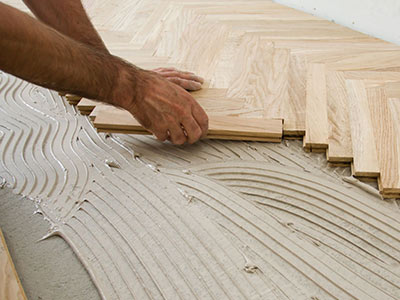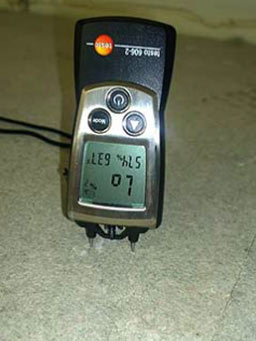Back to Wood Floor Fitting
Ultimate Guide to Wood Floor Glue Installation - Part Two
 Welcome back to the wood flooring gluing down installation series. In the first part of the article we have already discussed the different types of wood floor adhesives and whether or not gluing down your wooden floor is the best installation option for your project. Make sure to check out the first part of this handy guide. In this second part of the series, we continue digging more into the depths of the topic and help you ensure the best fitting option for your new hardwood floor, so you can enjoy a floor that lasts for decades and looks in perfect condition, providing you with stability, hard-wearing power, and durability.
Welcome back to the wood flooring gluing down installation series. In the first part of the article we have already discussed the different types of wood floor adhesives and whether or not gluing down your wooden floor is the best installation option for your project. Make sure to check out the first part of this handy guide. In this second part of the series, we continue digging more into the depths of the topic and help you ensure the best fitting option for your new hardwood floor, so you can enjoy a floor that lasts for decades and looks in perfect condition, providing you with stability, hard-wearing power, and durability.
Beware of the Old Types of Hardwood Floor Adhesives
We have already mentioned that the new and more innovative types of hardwood floor adhesives offered on the market are designed without featuring solvents as ingredients or with just a really small amount of them. This makes them absolutely harmless for people and nature, which means that new types of hardwood floor adhesives are eco-friendly and safe to use in your home. However, this might not be the case with old types of hardwood floor adhesives. Many of the hardwood floor adhesives and products used back in the days contain a considerable amount of harmful and even toxic ingredients and components.
As an example, until the seventies, a popular hardwood floor adhesive option used commonly used to be the black parquet adhesive. This type of adhesive features components such as coal tar, which can contain carcinogenic substances such as polycyclic aromatic hydrocarbons or PAH and polychlorinated biphenyls or PCBs. As you can expect, the usage of such type of glue can be pretty dangerous, especially in cases when something triggers the harmful substances to activate by reacting chemically to other products, for example, in cases when a defective sealant is used for finishing the floor.
In case the protective finishing layer of the floor is defective, not applied properly or simply worn, this leaves some areas of the floor with weakened surface protection, which could possibly allow the harmful and dangerous substances from the adhesive, such as benzopyrene, to transfer to the room’s air through the cracks, gaps, and scratches of the floor and bind to dust. However, if you know and you have found out that black hardwood floor adhesive is used for gluing down your existing wooden floor, do not panic, there is no need to immediately have the floor lifted and removed. You are simply recommended to have your floor regularly inspected and assessed by a professional, which involves regular dust tests in order to prevent the release of the harmful and toxic substances of the old adhesive.
Still, if you want to be absolutely safe or the existing hardwood floor is not in its best condition and you would like to replace it, you can definitely invest in such a project. However, remember that not only the old floor should be lifted and removed but also the subfloor underneath should be thoroughly and carefully treated so all the adhesive residue is removed completely. This would usually involve chiselling the screed since abrasive of the black wood floor adhesive is highly not recommended due to the risk of formation of toxic and dangerous dust.
In addition to the PAH and PCB components we have mentioned above, black wood floor adhesive can also feature some other harmful and dangerous ingredients. One of them being asbestos. The release of asbestos is often triggered by demolition or grinding work. Therefore, whenever you are planning a renovation and repair project for your hardwood floor, however, you know or at least suspect that wood floor adhesive containing asbestos has been used for the installation of the floor, make sure to hire a highly professional and specialised company for the project as the experienced experts will know how to handle such project while decreasing the potential risks to the minimum. There are professional wood floor renovation and sanding experts who have been specially trained in accordingly handling projects when harmful substances are involved in the process.
What Matters the Most When Gluing Parquet
 What matters the most in order to ensure a smoothly running installation project with minimal risk of possible issues and perfect results for a durable and beautiful wooden floor is making sure the hardwood floorboards are glued down to a dry, clean, and levelled subfloor along with optimal room conditions for the installation of a floor with the help of adhesives. The best room environment you can ensure for the installation of the floor involves a room temperature of at least 16°C and 40 to 60% humidity.
What matters the most in order to ensure a smoothly running installation project with minimal risk of possible issues and perfect results for a durable and beautiful wooden floor is making sure the hardwood floorboards are glued down to a dry, clean, and levelled subfloor along with optimal room conditions for the installation of a floor with the help of adhesives. The best room environment you can ensure for the installation of the floor involves a room temperature of at least 16°C and 40 to 60% humidity.
Now, before the hardwood floorboards are actually laid to the floor, the first three rows of floorboards should be laid without the usage of adhesive. This is done so individual elements can be cut to size and any changes made to the direction of installation later in the process.
Additionally, if you are planning to install the hardwood floor by yourself, make sure to get familiar with how to use the exact type of wood floor adhesive you have purchased. It is always recommended to read the manufacturer’s instructions first, even if this is not your first time working with a wood floor adhesive, as this will ensure you are using and applying the product properly and you will be able to achieve the best results. Use a small amount of the wood floor adhesive first to test it and see how it works and what you can expect. In a nutshell, modern wood floor adhesives are made to be pretty easy to apply and work with. However, keep in mind that handling the putty might require some practise in order to become easier for you. With time and when the project progresses, you will become better and faster at application.
When applying the adhesive, make sure to work in small sections step by step. The majority of wood floor adhesives offer a time window of optimal adhesive strength that usually lasts half an hour and this is the best time to have the floorboards laid to the subfloor in order to achieve the best results. Applying the adhesive in larger patches or covering the entire floor and then laying the floorboards will prevent you from taking advantage of the optimal power of the product.